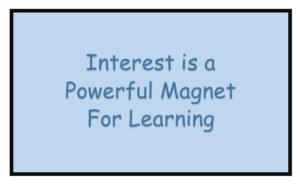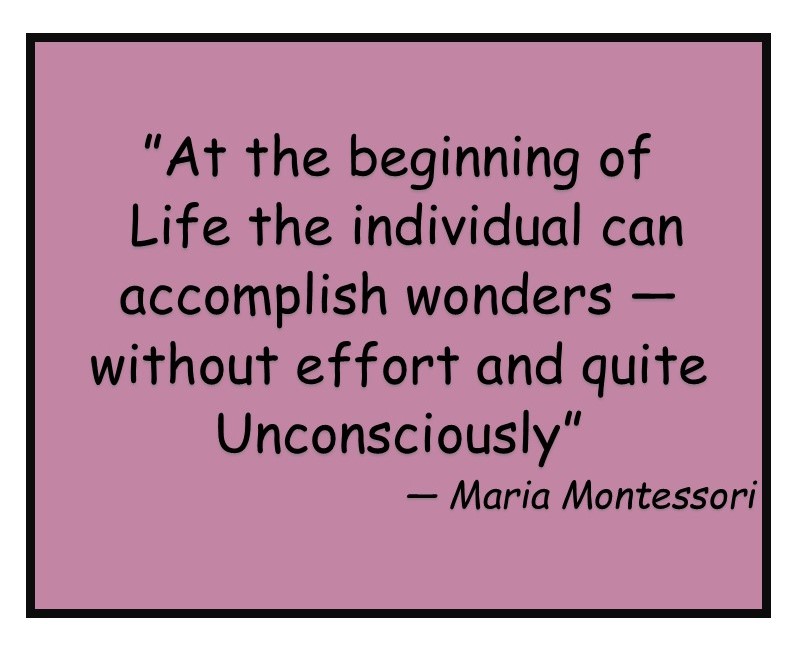What’s your long-term goal?
As I design curriculum, my long term goal is to help a child become a life-long learner — an adult to wants to keep up with what’s going on and feels some responsibility for having a positive impact on the world around them. For this they need skills. First, literacy skills, then higher-level thinking skills So then I look at what the young child is capable of and attempting to do, and I go from there.
And what I see is that during their early years, a child needs to focus on communication skills. For they’ve just recently learned to talk. So at this point, their major challenge is to learn to translate their own speech into print — and conversely, to translate other people’s print back into something that make sense to them.
Then once they can read and write, they’ll be ready for and higher-level thinking skills: investigation, analysis, and multi-media reporting. These are developed through “real life” projects. And it’s at that point they can begin to expand what they know about the world around them.
For a young child, the primary goal is skill development
I occasionally hear someone planning to teach something like Ancient or World History to a 2nd grader. These are extreme cases of thinking education in the early years should be a scaled down version of high school or university classes. So I’ll take a moment to address the role of content vs skill development for young children.
It’s important to recognize that during their early years, a child needs to focus on communication skills. For they’ve just recently learned to talk. So at this point, their major challenge is to learn to translate their own speech into print — and conversely, to translate other people’s print back into something that make sense to them.
Then once they can read and write, they’ll be ready for and higher-level thinking skills: investigation, analysis, and multi-media reporting. These are developed through “real life” projects. And it’s at that point they can begin to expand what they know about the world around them.
But even there, projects grow out of a unit of study which is focused on discovering more about something the child can relate to and is interested in. For more about curriculum, see What About Curriculum.
“meaningful” content
We also need to recognize that a young child is not yet able to comprehend much, if any, information about topics not tied to their own daily life.
 So for them, we can think of the topics they’re very interested in as meaningful content — things they understand and are very interested in. This would be things like popular holidays, pets, their favorite cartoon character, favorite people and foods, and so forth.
So for them, we can think of the topics they’re very interested in as meaningful content — things they understand and are very interested in. This would be things like popular holidays, pets, their favorite cartoon character, favorite people and foods, and so forth.
I’m not saying we don’t expand their thinking — that we never teach them anything new.
I’m saying we have to be sure it’s actually something meaningful to them. Otherwise, if far beyond their ability to comprehend (like ancient history), we’re just adding meaningless vocabulary they’ll soon forget.
Why work with what they already know? Because we more readily attach new skills to something we’re already at least somewhat familiar with.
Critical Features of This approach — Why it works so well!
 We’re capturing the child’s interest in something they already know — and tying it to new skills and concepts. This interest helps motivate the child to work day after day to perfect their new skills.
We’re capturing the child’s interest in something they already know — and tying it to new skills and concepts. This interest helps motivate the child to work day after day to perfect their new skills.
 We’re allowing the child to “learn by doing.” And that “doing” has a purpose. This is the most powerful way to incorporate new skills and concepts. By contrast, we’re not sorting out the skills and having the child practice them in isolation. We’re having them actually do something purposeful as they gain their new skills.
We’re allowing the child to “learn by doing.” And that “doing” has a purpose. This is the most powerful way to incorporate new skills and concepts. By contrast, we’re not sorting out the skills and having the child practice them in isolation. We’re having them actually do something purposeful as they gain their new skills.
First, they’re helping us spell the word they want — not memorizing sounds and letters in isolation. Later they’re rearranging sentences they’ve cut into individual words for the purpose of recreating a sentence to communicate their thoughts — never trying to memorize lists of sight words. (But this is actually what they’re accomplishing.)
Learning by doing is especially important at Step 3, when they’re cutting up, then reassembling the sentence. For no one really knows for certain exactly what we do when we read, and perhaps it differs from person to person. (We’ve all seen those strange looking paragraphs completely misspelled that somehow we can still read. All we really know for certain is that a rapid reader looks for quick clues: configuration of the word, beginning and ending letters. And they sometimes insert meaning where no word is there, and so on.)
And it’s much more difficult for the child if we pick reading skills apart and teach them separately, then expect the child to put them back together again during the act of reading. So Step 3 is especially valuable, as the child is gaining reading strategies in the way that works for them. (Just as they did with speech.)
Also, all the skills they’re working on are for the purpose of communicating what’s on their mind.
Montessori and the child’s absorbent mind
 Then if we zoom in and look at how we’re approaching this, we find we’re supporting the child’s natural way of learning. For instance, rather than attempting to “teach phonics” the way we all memorized the multiplication table (a much lower-level memory task), we expose the child to the sound/symbol relationship as we spell the words they want. And the child absorbs the connections, mostly unconsciously — without being aware of having made the effort to remember.
Then if we zoom in and look at how we’re approaching this, we find we’re supporting the child’s natural way of learning. For instance, rather than attempting to “teach phonics” the way we all memorized the multiplication table (a much lower-level memory task), we expose the child to the sound/symbol relationship as we spell the words they want. And the child absorbs the connections, mostly unconsciously — without being aware of having made the effort to remember.
Without having to give it much thought, you employed the same strategies when your child was learning to speak. You modeled words tied to something they were very interested in. They absorbed the meaning of the words and you had to be patient. For most of the time you couldn’t see them working at it. So you just waited for them to come out with the new words you’d been using — when they were ready.
For just as Montessori says, they practiced making the connections between the sounds they heard and the muscles they used to make them, in ways we could not always see and that they were also not aware of. And here, they’re doing the same with reading.
So with this natural approach, we are mirroring the way we help a child learn to speak. We’re just being a bit more intentional about it.